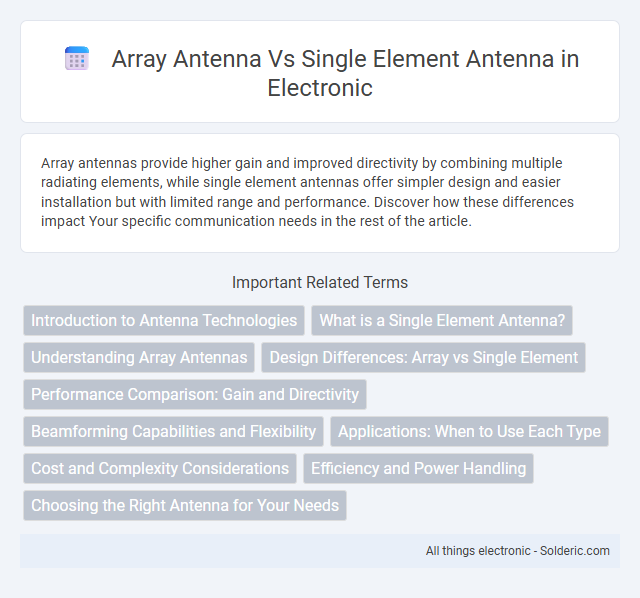Array antennas provide higher gain and improved directivity by combining multiple radiating elements, while single element antennas offer simpler design and easier installation but with limited range and performance. Discover how these differences impact Your specific communication needs in the rest of the article.
Comparison Table
| Feature | Array Antenna | Single Element Antenna |
|---|---|---|
| Structure | Multiple antenna elements arranged in a pattern | Single antenna element |
| Gain | High gain due to constructive interference | Lower gain, limited by single element size |
| Beamforming | Capable of beam steering and shaping | Fixed radiation pattern |
| Directivity | High directivity with narrow beamwidth | Omnidirectional or broader beamwidth |
| Size and Complexity | Larger size and more complex design | Compact and simple design |
| Cost | Higher cost due to multiple elements and electronics | Lower cost |
| Applications | Radar, satellite communication, MIMO systems | Simple wireless devices, handheld radios |
| Power Consumption | Higher due to active elements and control circuits | Lower power consumption |
Introduction to Antenna Technologies
Array antennas consist of multiple radiating elements arranged systematically to enhance signal gain, directivity, and beamforming capabilities, offering significant improvements over single element antennas. Single element antennas, typically simpler and smaller, provide basic transmission and reception but lack the advanced spatial control and increased signal strength achievable with array configurations. The integration of array antenna technology in modern communication systems enables enhanced performance for applications such as radar, wireless networks, and satellite communications.
What is a Single Element Antenna?
A single element antenna consists of one radiating component that transmits or receives electromagnetic waves, commonly used in simple or low-power communication systems. It offers a straightforward design with a fixed radiation pattern, limiting its ability to focus energy in specific directions compared to array antennas. Your choice of a single element antenna suits applications requiring compact size and uncomplicated installation without advanced beamforming capabilities.
Understanding Array Antennas
Array antennas consist of multiple radiating elements arranged to work collectively, enhancing signal strength and directivity compared to single element antennas. By controlling the phase and amplitude of each element's input, array antennas achieve beamforming, which improves gain and reduces interference. This configuration allows for adaptive radiation patterns, resulting in better performance in applications like radar, wireless communication, and satellite systems.
Design Differences: Array vs Single Element
Array antennas consist of multiple individual elements arranged in a specific geometric pattern to enhance directivity, gain, and beamforming capabilities, unlike single element antennas which rely on a solitary radiating part for signal transmission and reception. The design of array antennas involves complex phase and amplitude control mechanisms to achieve desired radiation patterns, whereas single element antennas have simpler structures with fixed radiation characteristics. Your choice between these designs depends on the application requirements for coverage, signal strength, and spatial filtering.
Performance Comparison: Gain and Directivity
Array antennas significantly outperform single element antennas in terms of gain and directivity due to the constructive interference of signals from multiple elements, resulting in narrower beamwidths and higher radiation intensity. The gain of an array antenna can be several times higher than that of a single element, providing enhanced signal strength and improved communication range. Directivity in array antennas is optimized through element spacing and phase control, enabling precise beam steering and reduced side lobes, which single element antennas cannot achieve effectively.
Beamforming Capabilities and Flexibility
Array antennas deliver superior beamforming capabilities by combining multiple elements to steer and shape signals precisely, enabling dynamic control over beam direction and gain. Single element antennas lack this flexibility, producing a fixed radiation pattern without the ability to adjust beams electronically. The spatial diversity and phase control inherent in array antennas allow adaptive beam steering and interference mitigation, critical for advanced communication systems.
Applications: When to Use Each Type
Array antennas provide enhanced directivity and gain, making them ideal for applications requiring precise beam steering and high signal strength, such as radar systems, satellite communications, and 5G networks. Single element antennas offer simplicity and cost-effectiveness, suitable for basic wireless communication, RFID systems, and low-power IoT devices. Choosing between array and single element antennas depends on factors like required coverage area, gain, and system complexity.
Cost and Complexity Considerations
Array antennas generally involve higher initial costs and increased design complexity compared to single element antennas due to the need for multiple radiating elements and advanced feeding networks. The manufacturing and maintenance expenses rise with the number of elements and the precision required for synchronized signal processing. Single element antennas offer simpler construction and lower costs, making them suitable for applications where budget constraints and ease of deployment are critical.
Efficiency and Power Handling
Array antennas offer significantly higher efficiency and power handling capabilities compared to single element antennas due to their ability to distribute input power across multiple radiating elements, reducing thermal stress and signal loss. The combined gain of array antennas enhances effective radiated power, improving overall system performance in high-power applications such as radar and wireless communication. Single element antennas, while simpler and easier to design, typically have lower power handling capacity and efficiency, limiting their suitability for high-power or high-efficiency requirements.
Choosing the Right Antenna for Your Needs
Array antennas provide enhanced directional gain and improved signal-to-noise ratio compared to single element antennas, making them ideal for applications requiring long-range communication or precise beamforming. Single element antennas are simpler, cost-effective, and suitable for short-range or omnidirectional coverage scenarios where space and budget constraints are critical. Evaluating factors such as coverage area, gain requirements, interference environment, and installation complexity helps determine whether an array antenna or a single element antenna best fits your specific wireless or radar system needs.
array antenna vs single element antenna Infographic

 solderic.com
solderic.com